Pilgrimage
THE ”NATIONAL REVIEW” ON THE HOLY MOUNT OF ATHOS: MONASTERY HILANDAR (1)
The Divine Throne of Eternal Serbia
Hilandar is first mentioned in 1076, as an abandoned Greek monastery Helandarion in a part of the Holy Mount of Athos. However, it is probable that the endower and the founder of the original Hilandar, almost one hundred years earlier, around 985, was the monk Georgis Helandarios. In documents from 1169, among the signers of the annual act stand the name of the prior of Hilandar called Gerasim, which points to the fact that 30 years before the arrival of St. Sava and St. Simeon (1197), a brotherhood already lived in that monastery
By: Mišo Vujović
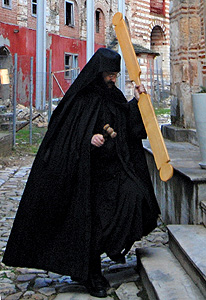 The December sun was bathing in the foamy waves, which were left behind the ship ”Agios Panteleimon”, leaving the port of Uranopolis to Daphne, the main port of the only monastic country in the world. A flock of sea gulls flew behind the great ship, white as snow, waiting for the food crumbs, which were thrown from the ship by monks and pilgrims. About ten years ago, the photograph which traveled around the world represented a monk from the Holy Mount of Athos from whose palm a white sea gull is taking pieces of bread, flying at rooftop level. This morning, the white squadron hunted its first morning meal. The December sun was bathing in the foamy waves, which were left behind the ship ”Agios Panteleimon”, leaving the port of Uranopolis to Daphne, the main port of the only monastic country in the world. A flock of sea gulls flew behind the great ship, white as snow, waiting for the food crumbs, which were thrown from the ship by monks and pilgrims. About ten years ago, the photograph which traveled around the world represented a monk from the Holy Mount of Athos from whose palm a white sea gull is taking pieces of bread, flying at rooftop level. This morning, the white squadron hunted its first morning meal.
Uranopolis, or the Divine Town, represented a port and a gate of a monastic country for centuries. Set in the oasis of the park of the Holy Mother of God, had an unusual scent. And the morning tumult before taking on ships which sailed to the Holy Mount of Athos had a kind of a praying harmony. In the 80s of the 20th century, this fishing settlement, because of its emerald sea clarity, sandy beaches and the proximity of the Holy Mount of Athos, became an attractive tourist destination. The town in which dominates the watchtower is left behind us. We sail along the coast, covered in low vegetation and olive groves. On only a few kilometers from Uranopolis begins the territory of the monastic country. On the peninsula’s slopes the remains of several smaller monastic communities sketes and hermitages.
”Imagine a prince today who is refusing his great power, taking of the silk and the velvet clothes and accepts poverty of monastic tonsure, from which the Serbian people will rise and finally begin to see”, says Dragan Tomić, one of the contributors of Hilandar.
IT HURTS TO THE BONE 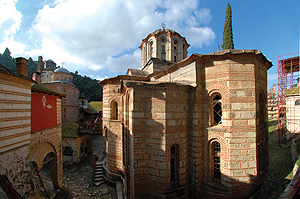 A beautiful December day and a few fishing boats on the blue high seas. ”Hilandar”, announces the ship captain, telling the passengers to prepare for landing. The ship lands on a church land called Jovanica. It is the first station from Uranopolis to Daphne. On a deserted monastery property, father Panteleimon, a born German, who accepted Orthodoxy twenty years ago, succeeded in renovating the deserted monastery pier in only a few years, the palace, the vineyard, the olive groves. German diligence, as spoke the late old man Mitrofan of Hilandar, made a small paradise for a short time of a deserted pier of the coast of the Holy Mount of Athos. A beautiful December day and a few fishing boats on the blue high seas. ”Hilandar”, announces the ship captain, telling the passengers to prepare for landing. The ship lands on a church land called Jovanica. It is the first station from Uranopolis to Daphne. On a deserted monastery property, father Panteleimon, a born German, who accepted Orthodoxy twenty years ago, succeeded in renovating the deserted monastery pier in only a few years, the palace, the vineyard, the olive groves. German diligence, as spoke the late old man Mitrofan of Hilandar, made a small paradise for a short time of a deserted pier of the coast of the Holy Mount of Athos.
Several hundred meters from Jovanica, we ran into a white blanket, which is not frequent for this time of year. On several places, it is half a meter thick. The old military ”pinzgauer” in which we drove last time in the army, successfully overcomes the snowdrifts. In about 20 minutes, we cross on the other side of the peninsula. In a picturesque and wooded part of the peninsula lies Hilandar.
”An eternal gift to the Serbian people”, wrote in 1198 the Byzantium Emperor Alexios III Angelos in his document in which he gives Hilandar to the great Stefan Nemanja and his son, the young monk Sava.
We stop on the hill above Hilandar.
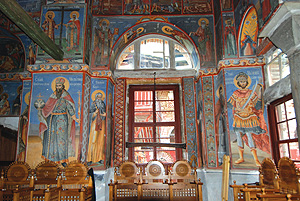 On March 12th 2004 from that same place I took photographs of the remains of the monastery building from which smoke was still gushing. Today, the sky above the holy monastery is covered in big building cranes. Chained with scaffoldings and metal constructions, the holy monastery reminds us of a former power of a nation and its country with its monumental character. In March 2004, two tragic events took place. The fire in Hilandar and the pogrom in Kosmet. At one moment we thought that the Hilandar and Kosmet flame would wake us up, that the soot of burning deeds would regain our consciousness. The same questions repeated this time again, while we were passing through the stone entrance of the monastery. On March 12th 2004 from that same place I took photographs of the remains of the monastery building from which smoke was still gushing. Today, the sky above the holy monastery is covered in big building cranes. Chained with scaffoldings and metal constructions, the holy monastery reminds us of a former power of a nation and its country with its monumental character. In March 2004, two tragic events took place. The fire in Hilandar and the pogrom in Kosmet. At one moment we thought that the Hilandar and Kosmet flame would wake us up, that the soot of burning deeds would regain our consciousness. The same questions repeated this time again, while we were passing through the stone entrance of the monastery.
Could only a chimney crack swallow all these centuries and some other endemic fissures have passed through this crack?
Isn’t it strange that Hilandar burns so easily? That pumps are blocked, electricity is gone, that helicopters do not fly, that firefighters are asleep? Did angels took a vacation or are they tired from the Serbian fighting, from fights in which we win only ourselves, and then repent for things we haven’t or have done?
The monks have testified that a force was fighting ear St. Sava’s chapel. Maybe the Saint tried to extinguish the fire, but he changed his mind, let it hurt to the bone. Leave a scar as a reminder. Not even the hegumenia of Hilandar, the Mother of God with three hands, did not raise her third hand. However, the Saint and the Protector did not let the fire get to Milutin’s endowment, with Lazar’s parvis in which lies the immortal Obilić’s sacrifice with an aureole.
THE SPRING, THE NURSERY, THE PEAK 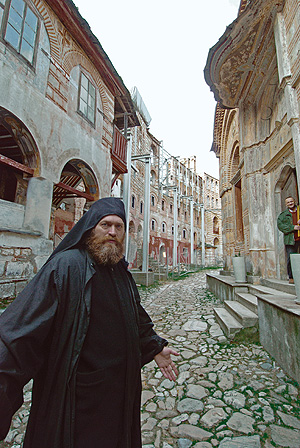 Monatery Hilandar was a part of the destiny of Serbian people. During the medieval Serbian country, Hilandar was very powerful, as a religious lighthouse, the first university, the biggest artistic workshop, the nursery of religious people and missionaries... Monatery Hilandar was a part of the destiny of Serbian people. During the medieval Serbian country, Hilandar was very powerful, as a religious lighthouse, the first university, the biggest artistic workshop, the nursery of religious people and missionaries...
Hilandar left a priceless treasury to its homeland, which only the great people can have. And the Serbian people, thanks to Hilandar and other endowments, above all the medieval ones, gave a priceless heritage to the world cultural treasury, which is today in Kosmet, bearing the brunt of new protected vandals.
Through history, as most of our medieval churches, it was raged, destroyed, burned... Only Milutin’s church is left intact, built on the bases of the old Nemanja’s church, which was built on the remains of the devastated Hilandar church. Hilandar was destroyed in pirate robberies, in earthquakes, of which the strongest was in 1585, when most of Hilandar towers were torn down. In several horrible fires, great heritage was lost. Most of the treasure was destroyed in the fires of 1722 and 1776. There were demolishing in order to make it bigger, more spacious and powerful.
Hilandar was the mirror of power of Serbian rulers for centuries. The power of Serbia was represented by it.
King Milutin torn down the small church, which was built by St. Simeon and St. Sava.
The medieval Serbian lords built these small churches and chapels, building themselves in them and their descendants in the eternity of Hilandar.
It has a special place in the soul of every Orthodox Serb. Many people still dream of going to the ”White Hilandar in the Holy Mount of Athos”.
Today in Hilandar, besides construction work which are believed to be finished in 2013, lasts the renovation of the monastery brotherhood.
The monk of Hilandar have accepted the horrible fire quietly, along with their zeal and prayer. The first Epitrope, father Metodije points us that the religious renovation of the monastery is in its prime and that it will build better basis and give a new strength to this church.
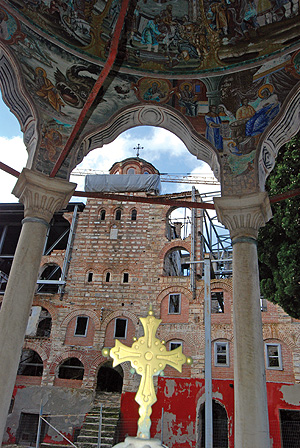 ”Since World War II the monastery brotherhood is most numerous. Forty monks and novices live and pray to God in Hilandar today. The brotherhood is rejuvenated, giving new strength and announcing better times fro Hilandar and the homeland”, says father Metodije, on whose young shoulders lies the great renovation of Hilandar. ”Since World War II the monastery brotherhood is most numerous. Forty monks and novices live and pray to God in Hilandar today. The brotherhood is rejuvenated, giving new strength and announcing better times fro Hilandar and the homeland”, says father Metodije, on whose young shoulders lies the great renovation of Hilandar.
In the last few years, right next to the monastery, there is a beautiful hospitable palace, a new bakery was built in which monk Milutin bakes the best monastic bread.
”Saint Simeon made a powerful empire, but he later saw the nonsense and the rotten character of this world’s powers with his religious eyes, and he departed with his youngest son, monk Sava”, says monk Milutin, pointing at the vine growing out of the myrrh-flowing grave, after St. Sava took his father’s relics in order to reconcile his brothers.
Father and Son, St. Sava and St. Simeon didn’t chose the Holy Mount of Athos by accident – the park of the Holy Mother of God, for their monastic adventure, which is the start of the horizontal and vertical lasting of Serbian people.
”The Holy Mount of Athos is an empire without a crown, a nation without an army, a country without women, a treasure without money, a wisdom without school, a kitchen without meat, an everlasting prayer, a connection with the sky with no interruptions, a hymn to Christ, death without regret”, sang St. Bishop Nikolaj of Žiča.
***
The myrrh and the vine of Saint Simeon
After his death on February 13th 1200, St. Simeon was buried on the south side of the monastery, where monk and pilgrims kiss his grave. Eight years later, because of the fight between Simeon’s/Nemanja’s sons Vukan and Stefan, St. Sava decided to bring his father’s relics in order to reconcile his brothers The holy myrrh flew out from the relics, which also flew from the grave. About 15 years ago, a Serbian priest from Holland Vojislav Bilbija, a man of a unique gift made a silver sarcophagus for the grave of St. Simeon the Myrrh-Flowing. After the moving of his relics, the vine grew out from the grave whose fruit still help sterile couples to get children.
The Hilandar church land, near Jerisos, lying on several tens of hectares, is a gift from the Turkish bay to whom the vine of St. Simeon helped in getting his heir.
***
Prayer for Esfigmenos
In the end of 80s of the 20th century, the Monastery Esfigmenos came into a fight with the Patriarchate of Constantinople (the Mount of Athos is under its jurisdiction), because of the dialogue with Patriarch Bartholomew with the Pope. Monastery Esfigmenos, whose motto is ”Orthodoxy or Death”, stopped all contacts and called off the obedience to the Ecumenical Patriarchate of Constantinople, and not mentioning their patriarch on divine liturgies. They sent a bishop from Constantinople to calm down the rebelled monks. The monks of Esfigmenos ”cancelled their hospitality” to the Bishop of Constantinople, who found shelter in Hilandar, from whose small brotherhood it was said that it was friendly with the attitude of their brothers from the neighboring monastery. The monk of Hilandar welcomed their unexpected guest. After the liturgy, the bishop of Constantinople, thanking the prior Nicanor for welcoming him, noticed that the monk of Hilandar do support the monk of Esfigmenos, even if they are mentioning the Patriarch of Constantinople.
”We meniton the patriarch, but we pray for our brother from Esfigmenos”, said Nicanor.
***
Bells
”An empty atheist soul needs no bells.” Said the young monk Amfilohije, the former student in Athens, a bit angry for the welcome of the communist ambassador Peko Dapčević in Hilandar, to the prior Mojsej.
”Don’t be mad, father Amfilohije. Not one knows what our souls keep inside and what the bells can find in it. We did not ring the bells for him but with the hope that those bells would wake something up in his empty soul”, said tenderly the old man. |
